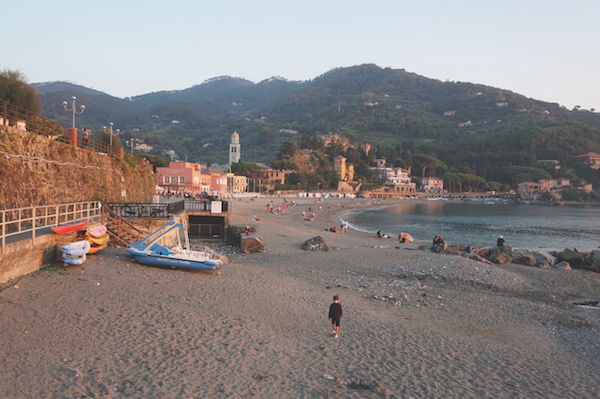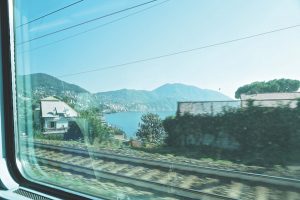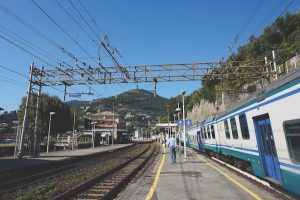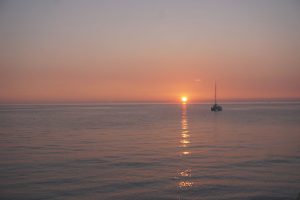Two decades ago Rachael Martin arrived in Italy, exploring the country by rail and dreaming of rooms with a view. Twenty years, one Italian husband and two kids later, she still has the memories of those first voyages of discovery…
Photos by Rachael Martin

When I first met my Italian husband he told me Liguria was for old people and families with small children, possibly because at the time we were young and didn’t have any children. Never believe your husband… (Or maybe it’s just that now we are the family with the kids.)

In any case, Liguria is seriously beautiful – that long stretch of Italian coast squeezed between sea and mountains that stretches from France’s Côte d’Azur then round and down to Tuscany in the east. Genoese poet Eugenio Montale immortalised it in his poem Meriggiare, pallido e assorto (To rest at noon, pale and absorbed) as a place whose desolate nature reveals the desolation of life itself. The Ligurian people, the Liguri – one of the first known Italian peoples after the Ice Age – are hardened to difficulty, the sea and the elements. Since I went there, it’s been battered by storms that have caused tremendous damage in some areas. Its capital Genoa – or Genova as it can only ever be – sits aware of its dangers. Genoa is the seafront with the motorway built over it. Genoa is, of course, the city where last year the bridge collapsed.
Today I’m retracing the popular route along the Riviera di Levante that many travelled when they came down from Milan, Turin and all the areas in between. The economic boom of 1960s Italy brought holidays and a surge in train travel as the preferable option to being stuck in traffic. This is the coastline where rich industrialists from Milan and Turin used to holiday, along with those who bought themselves a little place at the sea, and others who filled the guest houses every August. Nowadays it’s more the grandparents than
the mothers who are opening up houses at the seaside with the children. Italian summer holidays are three months long, and that’s a lot of time to cover in expensive summer camps.

At the third station we’re still in Genoa, then the view opens out and we follow the sea. It’s one of my favourite train journeys, this train that travels along the sea, possessing an elegance that reminds me of the Italian lakes, with its villas and gardens and that same air of exclusiveness, and waterside villages each with their own station. The train stops at Recco and I get off. According to a sign at the station, I’m in the gastronomical capital of Liguria. Focaccia di Recco is food of the gods, especially if you eat it on the beach, and today I’m here because I want to do precisely that. It’s a very thin focaccia, filled with fresh cheese and cooked in a very hot wooden oven; preferably to be eaten with your hands in the sunshine looking out to sea with the Ligurian hills behind you. I walk off with my focaccia to sit on the beach, trying to scoop up the cheese that oozes out as I eat. It’s that kind of eating that makes memories of the future. Eating focaccia on Recco beach on a day that’s almost in the middle of October during the summer that never seems to end.
Back on the train, and I’m off towards Levanto, past Camogli, one of Liguria’s most beautiful villages. They say it’s called Camogli, literally case delle moglie, or ‘houses of the wives’, in reference to the women that were (and are) left behind in this village that reputedly produced some of the best sailors. Their absence produced communities of women with their children; familiar chapters in familiar tales. So nothing’s changed there then. It’s still Italy’s women that are teaching the future to walk.

The next village is Santa Margherita, whose station also serves Portofino. Portofino is Liguria’s most desirable spot; the place everyone wants to come to and pay for an exclusivity that’s typically well-groomed. We continue to Rapallo, where Irish poet WB Yeats lived for a while. Then to Zoagli, Chiavari, Lavagna and Sestri Levante, with its lovely boutiques, and even lovelier Baia di Silenzio, backed by the archetypal pastel-coloured buildings.
I get off in Levanto today, to see the pinkest of sunsets and watch a man catch a squid, ink spilling out as he kills it. Levanto is the last village before the Cinque Terre, the five lands, or five villages, that is one of Italy’s jewels and another victim of the mass tourism that descends upon it mercilessly in spite of its ban on cars. After that there’s the Bay of Poets, named after the Romantic poets who used to go there, and then La Spezia with its links to the islands. The coast spreads southwards with promises of other journeys. This is the beauty of Italy. This is the beauty of the train.
I take a photo of the pink sunset to send back home to my children, slightly choked by the loveliness of
this country I call home, a country I fell so desperately in love with 20 years ago. The reality of living in
a place has its own effects, yet such romanticism doesn’t seem that inappropriate today.
Find more from Rachael’s Making Tracks series here
